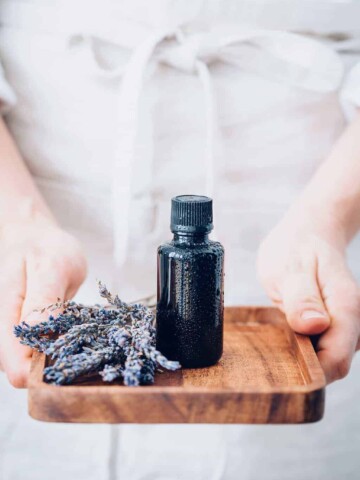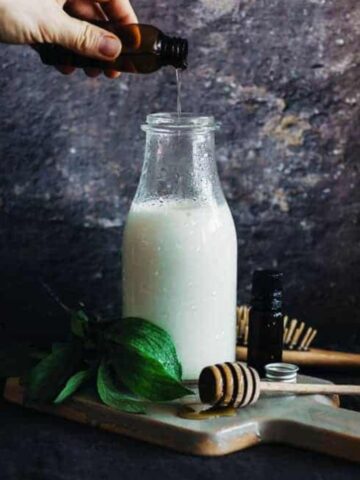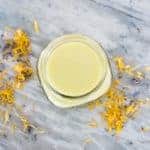I always keep a jar of this healing salve infused with lavender and calendula herbs next to the kitchen sink and bedside table. This lavender calendula salve is a must-have for dry skin, minor scrapes, and soft, supple hands!

Winter wreaks complete havoc on my hands. I'm talking peeling and cracking, itching, and lots of irritation. I've tried loads of different moisturizers and lotions, but they've all fallen short. Then, a friend shared a beeswax salve with me, and my hands were in heaven! Plus, it's incredibly easy to make at home.
Jump to:
Calendula Benefits for Skin

Renowned for its skin-healing properties, calendula is a pretty little flower that packs a powerful (yet gentle) punch.
1. Calendula soothes inflammation
Calendula officinalis, also known as marigold, is a plant that has been used for hundreds of years to soothe inflammation and nourish the skin [source]. Its medicinal properties are due, in part, to its numerous anti-inflammatory polyphenols, such as resveratrol, quercetin, and ferulic acid, which help calm inflammation and protect skin from oxidative damage [source].
2. Calendula heals damaged skin
Calendula, also known as pot marigold, is a very skin-healing herb—and the scientific community agrees, as studies have shown its use in wound care [source]. Salves and poultices made with calendula have been used for hundreds (and probably thousands!) of years.
When used topically in creams and ointments, calendula has been shown to increase skin healing. In a 30-week study that followed 41 adults with diabetes-related foot ulcers, 78% of participants saw complete wound healing after using calendula spray daily [source].
3. Calendula reduces scarring
A 2016 study showed that calendula might even increase the amount of collagen in wounds as they heal [source], which may lessen the appearance of scars.
4. Calendula combats acne
While scientific studies are slim, anecdotal evidence suggests that calendula may help reduce acne breakouts thanks to its antimicrobial and antibacterial properties [source].
5. Calendula hydrates skin
And it has been shown to improve skin hydration in an anti-aging cream [source].
How to Make Calendula Oil
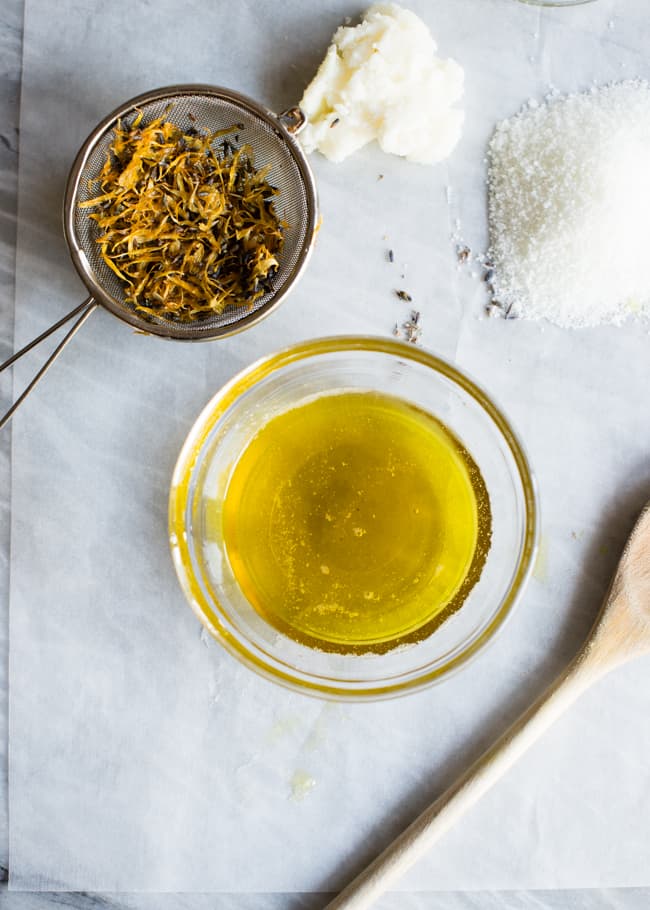
Ingredients
- Dried calendula petals — You can easily grow your own calendula and dry its petals for infusing or purchase some already dried online.
- Olive oil — Any natural oil, such as almond or coconut, will work for this recipe, but I recommend olive or grapeseed oil. You can also use jojoba oil, which mimics the oils our bodies naturally produce [source] and so maintains the skin's healthiest moisture balance while it hydrates and softens.
- One clean 8-ounce jar with a tight-fitting lid
Instructions

Make infusion: Fill your jar about halfway with calendula petals (roughly ½ cup).
Pour oil into the jar until it's just about full. The herbs will absorb some of the oil, so you won't end up with quite as much as you poured in.
Secure the lid onto the jar and place it in a sunny spot for about a month. Shake occasionally to redistribute the jar's contents.

Strain + bottle: After about a month has passed, pour the contents through a small strainer or a muslin bag, straining the oil (or pouring it once strained) into another clean jar or bottle. Straining can take some time, so don't rush this.
If you use a muslin bag, squeeze it around the herbs before discarding in order to get a few more good drops of the oil.
Storage
The calendula oil infusion doesn't need to be refrigerated—you can store it in your bathroom cabinet—but if it starts to smell off, it’s probably time to toss it and make more.
Usage
The oil is wonderful as a face and body moisturizer and works especially well when applied to wet skin just after cleansing. You can apply the oil to skin straight out of the shower or use it in homemade first-aid salves (see below!) and diaper creams.
Lavender Calendula Salve Recipe
This salve is a little oily (it's mostly oils, after all!) as it melts on your skin, but I find that it gets absorbed pretty quickly. The oils and butters in this recipe are also very healing for the skin.
Ingredients
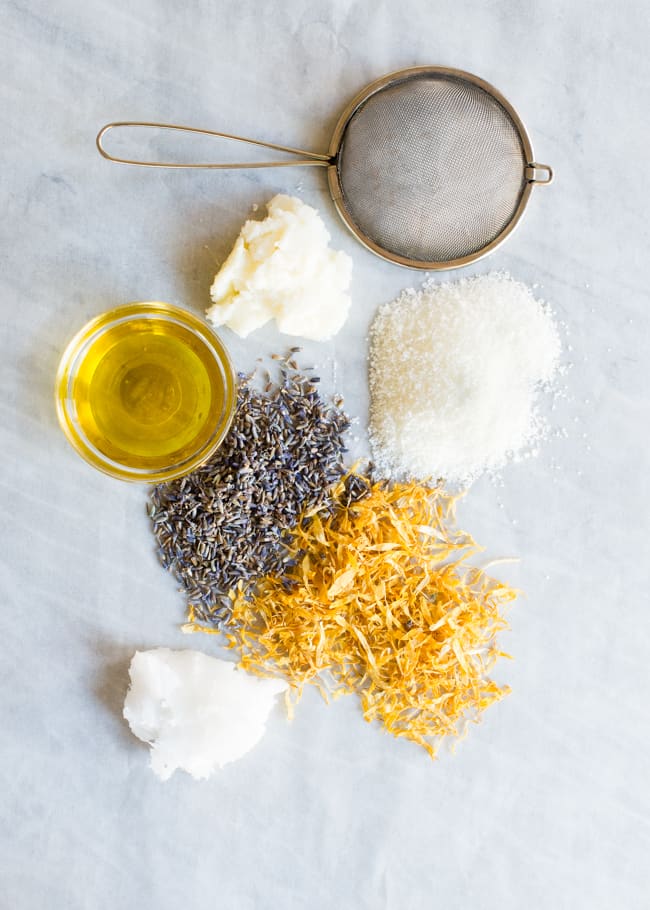
- Olive oil and shea butter to replenish essential fatty acids and repair the skin's moisture barrier.
- Coconut oil adds antimicrobial benefits to keep skin healthy [source].
- Dried lavender and dried calendula flowers for their skin supporting benefits.
- Beeswax pellets help seal in moisture.
Instructions

Step 1 | Melt oils: Combine the olive and coconut oils in a small pan or glass measuring cup and microwave in 30-second intervals until just melted.

Step 2 | Infuse herbs: Add the lavender and calendula to the warm oils and let steep for about 30 minutes then strain.
You can skip this infusion step if you're using calendula-infused oil. No need to combine two different oils; just use 5 ounces of the infused oil.

Step 3 | Add beeswax and shea butter: Pour back into the glass measuring cup and add the beeswax and shea butter.
Place the measuring cup in a saucepan filled ⅓ of the way with water and heat on low until the beeswax and shea butter are melted.

Step 4 | Add essential oil: Let cool for a few minutes, then add the lavender essential oil if using.
Step 5 | Transfer to a jar: Pour into a heat-safe, shallow jar with a tight-fitting lid.
Substitutions
Vegan — Carnauba wax is my favorite vegan wax. Since it has a slightly different texture than beeswax, feel free to adjust the measurements until your balm reaches the right consistency.
Essential oils — Lavender is a favorite when it comes to healing salves and balms [source] but you can also just use lavender essential oil instead of the dried herb infusion. Plus, it smells amazing.
Variations
Add honey: Try adding honey like in this honey hand balm recipe.
Experiment with other herbs: Although I rely on calendula and lavender to give this salve its healing powers, there are a lot of other herbs you can use instead. We like to use peppermint for headaches!
If you'd like to experiment, try some of these:
—Burdock
—Astragalus Root
—Angelica
—Camphor
—Turmeric
—Myrrh
[source]
Customize the consistency: You can adjust the balm's texture depending on your preferences. Use less beeswax for a softer salve and more beeswax for a firmer salve. To test the consistency ahead of time, place a spoon in the freezer right before making your salve.
After combining all your oils (step 4 above), dip the cold spoon in the oil mixture and quickly pull it out. The salve should solidify on the spoon within a few seconds, letting you test the consistency. Simply add more liquid oils for a creamier consistency and more beeswax for a firmer one
Want more balm recipes? Check out these 13 Homemade Herbal Balms and Salves
Storage
Pour into a clean, sterilized jar and close with a tight-fitting lid. This healing salve will keep for 6 months to a year.
Usage
Use it as often as needed to keep cracks and inflammation at bay. Oh, and it isn't just for hands either—use it on your feet, lips, elbows, knees, or anywhere that needs some TLC.
To speed up healing for dry, cracked hands, apply at night before bed and wear gloves to lock in the moisture.
FAQ
Calendula is safe to use topically [source]. If you wish to take it orally, you should always consult your doctor before use.
Calendula itself is actually great for acne-prone skin. But when making your own calendula-infused oil, you need to be careful about the carrier oils you use. For example, jojoba (known to be anti-acne [source]), sweet almond, and grapeseed oils are all noncomedogenic, meaning they shouldn't clog pores.
More Lavender Recipes
If you want more ways to incorporate lavender into your routine, check out these recipes as well:
Lavender Calendula Healing Hand Salve
Equipment
- Glass measuring cup
- Pan of simmering water
- Fine mesh strainer
- 8 ounce jar with lid
Materials
- 3 ounces olive oil
- 2 ounces coconut oil
- 1 tablespoon dried lavender
- 1 tablespoon dried calendula petals
- 2 ounces beeswax pellets (white or yellow)
- 2 ounces shea butter
- 50 drops lavender essential oil
Instructions
- Combine coconut and olive oils in a glass measuring cup, and microwave in 30-second intervals until melted.
- Add the dried calendula petals and lavender buds.
- Let stand for 30–60 minutes then strain. (Warm again if it's too thick to strain.)
- Place the infused oil back into the measuring cup, and add the beeswax and shea butter. Heat in the microwave for 1–2 minutes, stirring frequently. (If you're worried about breaking down the beneficial properties in the herbs, place the measuring cup in a saucepan filled ⅓ of the way with water, and heat on low until the beeswax and shea butter are melted.)
- Remove from heat, and add the lavender essential oil (if using).
- Pour the mixture into a heat-proof glass container and let cool completely.
Notes
References
Jahdi F, et al. The impact of calendula ointment on cesarean wound healing: a randomized controlled clinical trial. J Family Med Prim Care. 2018.
Ferreira MS, et al. Trends in the use of botanicals in anti-aging cosmetics. Molecules. 2021.
Akhtar N, et al. Calendula extract: effects on mechanical parameters of human skin. Acta Pol Pharm. 2011.
Arora D, et al. A review on phytochemistry and ethnopharmacological aspects of genus Calendula. Pharmacogn Rev. 2013.
Frum A. HPLC determination of polyphenols from Calendula officinalis L. flowers. Acta Univ Cibiniensis, Ser E: Food Technol. 2017.
Buzzi M, et al. A prospective, descriptive study to assess the clinical benefits of using Calendula officinalis hydroglycolic extract for the topical treatment of diabetic foot ulcers. Ostomy Wound Manage. 2016.
Nicolaus C, et al. In vitro studies to evaluate the wound healing properties of Calendula officinalis extracts. J Ethnopharmacol. 2017.
Arora D, et al. A review on phytochemistry and ethnopharmacological aspects of genus Calendula. Pharmacogn Rev. 2013.
Gad HA, et al. Jojoba oil: an updated comprehensive review on chemistry, pharmaceutical uses, and toxicity. Polymers (Basel). 2021.
Samuelson R, et al. The effects of lavender essential oil on wound healing: a review of the current evidence. J Altern Complement Med. 2020.
Shedoeva A, et al. Wound healing and the use of medicinal plants. Evid Based Complement Alternat Med. 2019.
Lima EBC, et al. Cocos nucifera (L.) (Arecaceae): a phytochemical and pharmacological review. Braz J Med Biol Res. 2015.
Andersen FA, et al. Final report of the Cosmetic Ingredient Review Expert Panel amended safety assessment of Calendula officinalis-derived cosmetic ingredients. Int J Toxicol. 2010.
This article was medically reviewed by Dr. Gina Jansheski, a licensed, board-certified physician with more than 20 years of practice experience. Learn more about Hello Glow's medical reviewers here. As always, this is not personal medical advice, and we recommend that you talk with your doctor.
259

